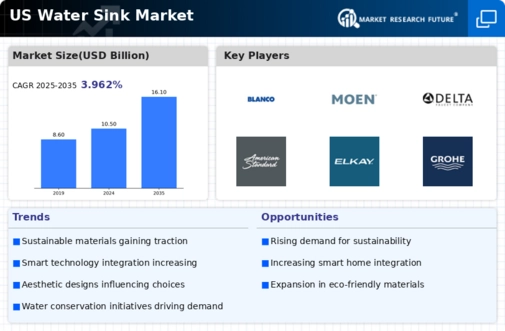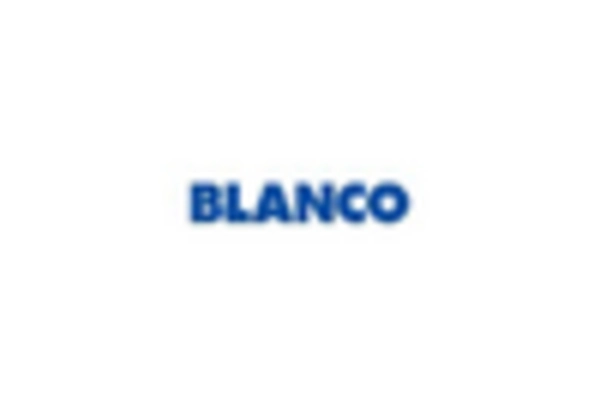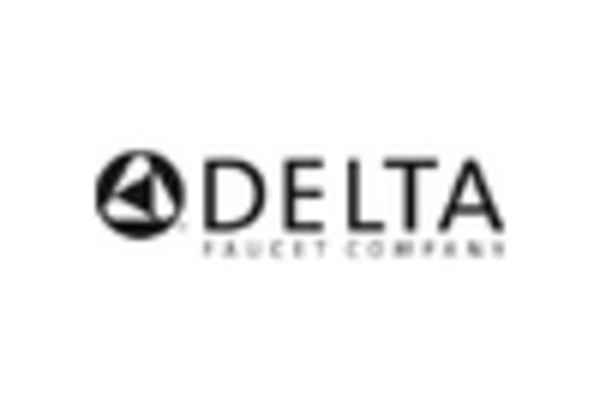Growing Urbanization Trends
The ongoing trend of urbanization in the United States is significantly impacting the water sink market. As more individuals and families move to urban areas, the demand for compact and multifunctional sink designs is increasing. Urban living often necessitates efficient use of space, prompting consumers to seek sinks that maximize utility without compromising on style. Market data reveals that urban housing developments are projected to rise by 15% over the next few years, further driving the need for innovative sink solutions. This shift towards urbanization influences the water sink market, as manufacturers respond by creating products tailored to the unique needs of urban dwellers.
Health and Hygiene Awareness
In recent years, there has been a marked increase in health and hygiene awareness among consumers in the United States. This heightened consciousness significantly impacts the water sink market, as individuals prioritize cleanliness and sanitation in their daily lives. The demand for sinks that facilitate better hygiene practices, such as touchless faucets and easy-to-clean surfaces, is on the rise. Market data indicates that the sales of touchless sink technology have surged by approximately 30% in the last year alone. This trend reflects a broader shift towards products that promote health and safety, particularly in residential and commercial settings. As a result, the water sink market is likely to see continued growth driven by consumer preferences for hygienic solutions.
Rising Renovation Activities
The water sink market experiences a notable boost due to the increasing trend of home renovations across the United States. As homeowners invest in upgrading their kitchens and bathrooms, the demand for modern and aesthetically pleasing sinks rises. According to recent data, the home renovation market is projected to grow at a CAGR of 4.5% through 2026, which directly influences the water sink market. Renovation projects often prioritize high-quality materials and innovative designs, leading to a shift towards premium sink options. This trend not only enhances the functionality of spaces but also elevates the overall value of properties. Consequently, the water sink market benefits from this surge in renovation activities, as consumers seek to incorporate stylish and durable sinks into their upgraded living environments.
Emergence of Eco-Friendly Materials
The water sink market is increasingly influenced by the emergence of eco-friendly materials as consumers become more environmentally conscious. The demand for sinks made from sustainable resources, such as recycled metals and biodegradable composites, is gaining traction. Recent statistics suggest that the market for eco-friendly home products is expected to grow by 25% over the next five years. This shift towards sustainability not only aligns with consumer values but also encourages manufacturers to innovate and develop greener products. As a result, the water sink market is adapting to these changes, with a growing number of brands offering eco-friendly sink options that appeal to environmentally aware consumers.
Technological Advancements in Manufacturing
Technological advancements in manufacturing processes are reshaping the water sink market, enabling the production of more efficient and innovative products. The integration of automation and advanced materials technology allows manufacturers to create sinks that are not only durable but also feature intricate designs and functionalities. For instance, the use of 3D printing technology has revolutionized the way sinks are designed and produced, leading to a wider variety of styles and customizations. Market analysis indicates that the adoption of such technologies could enhance production efficiency by up to 20%, thereby reducing costs and improving product availability. Consequently, the water sink market stands to benefit from these advancements, as they facilitate the introduction of cutting-edge sink solutions.

















Leave a Comment